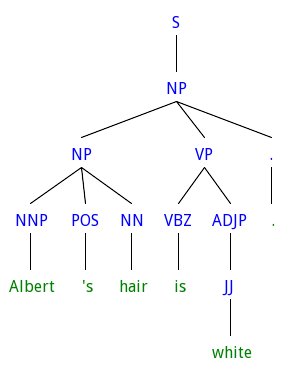English to Syntax Trees and Object References
by Peter Chapman
The first pass at the parser is complete for English. It generates a syntax tree for a given line of English (shown to the left here). This has started me thinking about how to resolve object references which include pronouns. In the example shown to the left, who is “Albert”?
The problem set is similar to a symbol table for a normal compiler. When a computer language references a variable, it follows a language specific set of sort of pre-defined rules. Example, first look for a local variable of the same name, then look at field names in the class and finally in the global scope for global variables.
However, English and more correctly, people seem to be very scattered and the rules are much more difficult to figure out. I think the best approach would be a stack (or maybe a tree?) based concept of different scopes. As new topics are presented, a new scope is created and pushed onto the stack (or maybe added as a peer, hence a tree?). There is a concept of current scope that points to particular scope (most likely the top of the stack).
When a reference is made, it searches using a particular order from most recent to the bottom which defines the global scope.
Certain actions would create clear delimitations of scope or branches in the tree. For instance, opening a new document or web page for reading would define a whole new scope clearly apart from the previous scope. But may still have vestigial traces to the previous context in case the pages or documents are related. Maybe as more and more relations between documents are found, the scopes would be brought closer together. And as time progresses, scopes would be more clearly separated or deleted to save resources.
Interesting enough, I found this paper that details a somewhat similar approach to my own: A Plan Recognition Model for Subdialogues in Conversations by DIANE J. LITMAN and JAMES F. ALLEN. The section describing the “discourse context” and “Subdialogs” is to what I refer vs. the discussion about the concept of plans.

[…] a previous post, I had started to think about object references (proper nouns) and how that should work. After […]